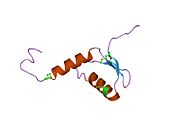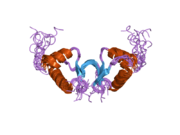Protein-coding gene in the species Homo sapiens
GTF2H5 Identifiers Aliases GTF2H5 External IDs OMIM : 608780 ; MGI : 107227 ; HomoloGene : 45635 ; GeneCards : GTF2H5 ; OMA :GTF2H5 - orthologs Gene ontology Molecular function Cellular component Biological process
termination of RNA polymerase I transcription regulation of transcription, DNA-templated transcription initiation from RNA polymerase I promoter transcription elongation from RNA polymerase II promoter 7-methylguanosine mRNA capping transcription by RNA polymerase II transcription, DNA-templated cellular response to DNA damage stimulus global genome nucleotide-excision repair cellular response to gamma radiation rRNA processing transcription-coupled nucleotide-excision repair transcription initiation from RNA polymerase II promoter nucleotide-excision repair, DNA incision nucleotide-excision repair, preincision complex assembly nucleotide-excision repair nucleotide-excision repair, DNA incision, 5'-to lesion DNA repair nucleotide-excision repair, preincision complex stabilization transcription elongation from RNA polymerase I promoter phosphorylation of RNA polymerase II C-terminal domain nucleotide-excision repair, DNA duplex unwinding nucleotide-excision repair, DNA incision, 3'-to lesion Sources:Amigo / QuickGO
Wikidata
General transcription factor IIH subunit 5 is a protein that in humans is encoded by the GTF2H5 gene .[ 5] [ 6]
Function
The GTF2H5(TTDA) gene encodes a small (71 amino acid) protein that stabilizes the multi-subunit transcription repair factor IIH (TFIIH). TFIIH plays a key role in a major DNA repair process, nucleotide excision repair (NER), by opening the DNA double helix after the initial recognition of damage in one strand. This step is followed by excision of the damaged region to generate a single-strand gap, and then repair synthesis, using the undamaged strand as template, to accurately fill in the gap. Disruption of the GTF2H5(TTDA) gene in a knockout mouse -model completely inactivates NER.[ 7] trichothiodystrophy phenotype. These genes are TTDN1 , XPB XPD GTF2H5(TTDA) .[ 7]
Interactions
GTF2H5 has been shown to interact with GTF2H2 [ 5] [ 8] XPB .[ 5]
References
^ a b c GRCh38: Ensembl release 89: ENSG00000272047 – Ensembl , May 2017^ a b c GRCm38: Ensembl release 89: ENSMUSG00000034345 – Ensembl , May 2017^ "Human PubMed Reference:" . National Center for Biotechnology Information, U.S. National Library of Medicine .^ "Mouse PubMed Reference:" . National Center for Biotechnology Information, U.S. National Library of Medicine .^ a b c Giglia-Mari G, Coin F, Ranish JA, Hoogstraten D, Theil A, Wijgers N, Jaspers NG, Raams A, Argentini M, van der Spek PJ, Botta E, Stefanini M, Egly JM, Aebersold R, Hoeijmakers JH, Vermeulen W (June 2004). "A new, tenth subunit of TFIIH is responsible for the DNA repair syndrome trichothiodystrophy group A" . Nat. Genet . 36 (7): 714– 9. doi :10.1038/ng1387 PMID 15220921 . ^ "Entrez Gene: GTF2H5 general transcription factor IIH, polypeptide 5" .^ a b Theil AF, Hoeijmakers JH, Vermeulen W (2014). "TTDA: big impact of a small protein". Exp. Cell Res . 329 (1): 61– 8. doi :10.1016/j.yexcr.2014.07.008 . PMID 25016283 . ^ Vermeulen W, Bergmann E, Auriol J, Rademakers S, Frit P, Appeldoorn E, Hoeijmakers JH, Egly JM (November 2000). "Sublimiting concentration of TFIIH transcription/DNA repair factor causes TTD-A trichothiodystrophy disorder". Nat. Genet . 26 (3): 307– 13. doi :10.1038/81603 . PMID 11062469 . S2CID 25233797 .
Further reading
Vermeulen W, Bergmann E, Auriol J, Rademakers S, Frit P, Appeldoorn E, Hoeijmakers JH, Egly JM (2000). "Sublimiting concentration of TFIIH transcription/DNA repair factor causes TTD-A trichothiodystrophy disorder". Nat. Genet . 26 (3): 307– 13. doi :10.1038/81603 . PMID 11062469 . S2CID 25233797 . Coin F, Proietti De Santis L, Nardo T, Zlobinskaya O, Stefanini M, Egly JM (2006). "p8/TTD-A as a repair-specific TFIIH subunit" . Mol. Cell . 21 (2): 215– 26. doi :10.1016/j.molcel.2005.10.024 PMID 16427011 . Giglia-Mari G, Miquel C, Theil AF, Mari PO, Hoogstraten D, Ng JM, Dinant C, Hoeijmakers JH, Vermeulen W (2006). "Dynamic interaction of TTDA with TFIIH is stabilized by nucleotide excision repair in living cells" . PLOS Biol . 4 (6): e156. doi :10.1371/journal.pbio.0040156 PMC 1457016 PMID 16669699 . Vitorino M, Coin F, Zlobinskaya O, Atkinson RA, Moras D, Egly JM, Poterszman A, Kieffer B (2007). "Solution structure and self-association properties of the p8 TFIIH subunit responsible for trichothiodystrophy". J. Mol. Biol . 368 (2): 473– 80. doi :10.1016/j.jmb.2007.02.020 . PMID 17350038 .
PDB gallery
1ydl : Crystal Structure of the Human TFIIH, Northeast Structural Genomics Target HR2045.
2jnj : Solution structure of the p8 TFIIH subunit







